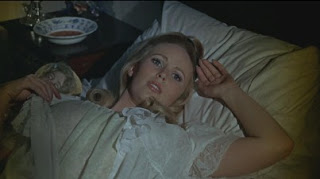A year later, a Monsignor (complete with unnecessary voice-over) stops into town to see how things have been going since Dracula was vanquished. He's not pleased to find that the priest has said a quick mass to an empty church then nipped off to the pub to get plastered. It turns out that the congregation stay away because the shadow of Dracula's castle touches it, so the Monsignor drags the priest up the mountain to perform an exorcism. The priest, a sweaty coward, pikes out halfway up the mountain so the Monsignor goes on alone. As a thunderstorm rages, he chants some Latin and wedges an enormous crucifix though the door latch.
Meanwhile, the sweaty cowardly priest has managed to fall down a bank and hit his head on some ice - which just happens to contain the frozen body of Dracula. The ice cracks and the priest's blood trickles into Dracula's mouth. But when he gets back to the castle, he is royally pissed to find what's happened to his home.
Straight away the tone of this movie is very different to the earlier movies in this series. There's much more of an emphasis on the visual aspect of the movie, which isn't really a surprise because it's directed by the great cinematographer Freddie Francis (who was a genius to the end - his last movie was David Lynch's The Straight Story, which he shot when he was 82). Francis didn't pull a Mario Bava and shoot Dracula Has Risen from the Grave himself, but he did let Arthur Grant use the gear that had served him so well on The Innocents, allowing Grant to mimic some of Francis's trademark deep focus work. This movie always look good, but the scenes with Dracula all have a special edge with interesting lighting, filters and unusual camera placement.
The movie makes more out of religious iconography than usual, and is the only vampire movie I'm aware of where staking only works if you also pray over the body. This leads to a particularly spectacular scene near the end, much to the atheist hero's chagrin. It doesn't have a particularly coherent religious moral, though the "Dracula can't be killed by an atheist" idea hints at something pretty interesting.
The sexual aspect is pushed to the forefront even more than in previous movies, both in terms of Dracula himself and with the supporting characters. Barbara Ewing as Zena particularly makes a lot of her sexual appetite (as with Dracula: Prince of Darkness the movie edges into misogyny here) but the sexiest scene by far is Dracula's seduction of the seemingly-willing heroine Maria, played by Hammer regular Veronica Carlson.


In this scene, Diana opens her window and then lays back passively on her bed waiting for Dracula, baring her neck languidly. He enters and nuzzles her face with his before leaning in for the bite. As she moans, the camera cuts to her hand grasping a doll and then dropping it to the floor in a pretty blunt piece os symbolism.
There's an unforgivable moment early on when the priest first sees Dracula as a reflection in the water. The day-for-night scenes, although quite lovely in their way, look even less like night than most day-for-night photography so that it often seems that Dracula is wandering around in the sunlight. Although these are all visually striking moments, they seem to indicate that Freddie Francis was less conscientious a director than Terence Fisher, and cared much more about visual effect than thematic consistency.
One thing I found very interesting is the change in attitude towards the authority figures in the movie. The village priest directly causes the resurrection of Dracula through his own spinelessness; the Monsignor, though in many ways a sympathetic figure, manages to bring danger to his own home through his attempts to exorcise the evil, and is portrayed as being unduly inflexible. Even though the movie emphasises that religious belief is necessary to defeat Dracula, the young atheist hero is the one who ultimately prevails - with the eventual assistance of the priest, who defies Dracula (his own authority figure) in the final act.
The gruesomeness of the ending also worked for me. Dracula is staked by Paul, but as he is an atheist and therefore cannot pray over him, Dracula pulls the stake out of his own chest with much spurting of blood. Then in the finale, he is impaled upon the cross that had been used to seal his castle; the priest prays over him, and Dracula bleeds messily from his eyeballs before crumbling to dust.

So what we lose in thematic richness we gain in sex and violence. It would be nice if we could have both in the same movie.
Tomorrow: Taste the Blood of Dracula. Yum!







No comments:
Post a Comment